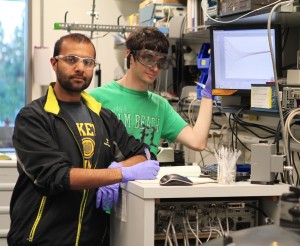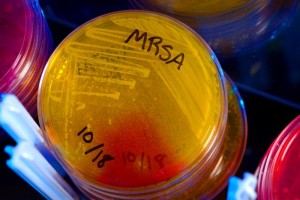By John Greenwald, Princeton Plasma Physics Laboratory

Researchers at the U.S. Department of Energy’s Princeton Plasma Physics Laboratory (PPPL) and the Max Planck Institute of Plasma Physics in Germany have devised a new method for minimizing turbulen
ce in bumpy donut-shaped experimental fusion facilities called stellarators. This week in Physical Review Letters, these authors describe an advanced application of the method that could help physicists overcome a major barrier to the production of fusion energy in such devices, and could also apply to their more widely used symmetrical donut-shaped cousins called tokamaks. This work was supported by the DOE Office of Science.
Turbulence allows the hot, charged plasma gas that fuels fusion reactions to escape from the magnetic fields that confine the gas in stellarators and tokamaks. This turbulent transport occurs at comparable levels in both devices, and has long been recognized as a challenge for both in producing fusion power economically.
“Confinement bears directly on the cost of fusion energy,” said physicist Harry Mynick, a PPPL coauthor of the paper, “and we’re finding how to reshape the plasma to enhance confinement.”
The new method uses two types of advanced computer codes that have only recently become available. The authors modified these codes to address turbulent transport, evolving the starting design of a fusion device into one with reduced levels of turbulence. The current paper applies the new method to the Wendelstein 7-X stellarator, soon to be the world’s largest when construction is completed in Greifswald, Germany.
Results of the new method, which has also been successfully applied to the design of smaller stellarators and tokamaks, suggest how reshaping the plasma in a fusion device could produce much better confinement. Equivalently, improved plasma shaping could produce comparable confinement with reduced magnetic field strength or reduced facility size, with corresponding reductions in the cost of construction and operation.
The simulations further suggest that a troublesome characteristic called “stiffness” could occur in reactor-sized stellarators. Stiffness, the tendency for heat to rapidly escape as the plasma temperature gradient rises above a threshold, has been observed in tokamaks but less so in stellarators. The possibility that stiffness might be present in reactor-sized stellarators, wrote the authors, could stimulate efforts “toward further optimizing stellarator magnetic fields for reduced turbulence.”
PPPL, on Princeton University’s Forrestal Campus in Plainsboro, New Jersey, is devoted to creating new knowledge about the physics of plasmas — ultra-hot, charged gases — and to developing practical solutions for the creation of fusion energy. Fusion takes place when atomic nuclei fuse and release a burst of energy. This compares with the fission reactions in today’s nuclear power plants, which operate by splitting atoms apart.
Results of PPPL research have ranged from a portable nuclear materials detector for anti-terrorist use to universally employed computer codes for analyzing and predicting the outcome of fusion experiments. The laboratory is managed by the University for the U.S. Department of Energy’s Office of Science, which is the single largest supporter of basic research in the physical sciences in the United States, and is working to address some of the most pressing challenges of our time.
Xanthopoulos, P.; Mynick, H.E.; Helander, P.; Turkin, Y.; Plunk, G.G.; Jenko, F.; Görler, T.; Told, D.; Bird, T.; J.H.E. Controlling turbulence in present and future stellarators. Article published in Physical Review Letters on Oct. 7, 2014.




You must be logged in to post a comment.